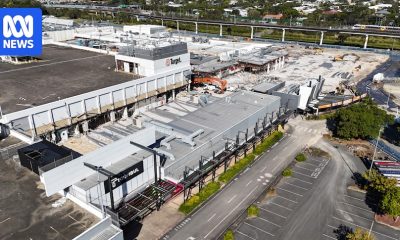Technology
How to Build a Gaming PC for Under $1200 – Gizmodo Australia
Sold.

PC gaming can be cheap when it comes to buying games, thanks to endless Steam and Epic sales, but its less forgiving on your wallet when it comes to buying the actual hardware, right? Not if you build your next gaming PC with a little smart shopping and planning.
This year will see the launch of new consoles promising amazing visual power but they wont be cheap, especially for the early adopters who must have them on day one. Its the same story with PC gaming, right? Those brand-new top-tier GPUs can seriously deplete your bank account just by themselves.
Its true you can spend an awful lot of money on getting a gaming rig together that combines the very best cutting-edge GPU, processors, storage and memory, not to mention monitors, keyboards, game controllers and more.
But you dont have to.
If your budget knows no limits, go nuts and buy me one while youre at it, but in the world most of us occupy, there are serious limitations on what you can afford to throw into a gaming PC at all. All those other pesky real world needs like food and rent seriously cut into your hardware budget. But the good news is you dont have to spend an absolute fortune to get a quite capable gaming rig, especially if you plan out your purchases and make the most of your buying dollar.
Its even feasible to build up a quite capable VR-ready rig for under $1,200, though youre likely to hit a few visual limits that those on higher budgets will sail past.
So what should you consider when trying to build a more budget-centric gaming PC?
Patience is your best friend
If theres one tip to keep in mind, its this: dont buy everything all at once. Waiting around for parts to drop in price helps you to economise not once, but twice. Over time, component prices drop, so you win there, but being patient also allows you to take advantage of spot sales for just about every part you might need. You can always safely store away that bargain CPU you scored while you wait for your GPU of choice to dip in price.
Consider upgrade paths
Its trickier when youre buying budget parts, where older motherboards might not support future processors quite as well, but one of the joys of building your own gaming PC beyond the challenge itself is that you can then provide it upgrades in the future to keep it ticking along. Thats as long as your system can take those upgrades, so check motherboard and processor roadmaps carefully before making your buying choices. AMD is typically a little friendlier to the budget buyer in this regard than Intel.
Intel or AMD?
This may come down to what you can get at the right price when youre clicking on that online checkout button, but typically speaking AMD has served the budget market a little better with its Ryzen processor lines than Intels Core equivalents, which tend to be pricier. On the other hand, Intels CPUs often overclock and perform better for gaming tasks at the top end. Its a balancing act with both firms competing for gamer dollars.
SSD over Mechanical drives
Weve pretty seriously switched in terms of price and performance for gamer needs towards SSDs, although it can be tempting to opt for a cheaper mechanical hard drive. If you do plan on having lots of games installed at any one time because you adore staring at your pile of shame or something, then the higher capacities you can score for the same money with a mechanical drive can be tempting. However, thats going to incur a really serious performance penalty on your whole system, which is a price that most gamers arent going to want to pay.
Use what youve got, but be smart
Unless youre absolutely brand-spanking new to the PC gaming scene, chances are that youre upgrading from an existing PC. In that case, the temptation to use existing components that you already own to save money can be strong. Its not a bad move either if youve got, for example a desktop case going begging. Thats money saved right there with some caveats. Bear in mind that an older desktop might not have a power supply unit capable of powering your new setup appropriately, or it may just be on its last legs.
If its a mass produced brand-name PC case, it may have an unusual or outdated rear panel setup which may not fit your choice of motherboard appropriately for the rear ports youre going to want. For peripherals you can always make do with existing mice, keyboards and controllers if youve got them, or budget for future upgrades, but theres less reason to hold onto an older monitor, especially if its not capable of supporting modern refresh rates. Pairing up an old monitor and a new gaming PC is going to rob you of the precise benefits that youre spending on a gaming PC for!
Dont forget to budget for the OS!
Sure, Steam has Linux support, but its a smaller subset of available titles, and the same is true on the Mac side of the equation. With macOS going all ARM with macOS Big Sur, the market for Hackintoshes is likely to dry up very quickly. That means that Windows 10 is your OS of choice, and if youre building a new PC, youve got to factor in the cost of that OS licence. Theres nothing specifically illicit about using an OEM copy, typically much cheaper when bundled with hardware components that youre buying anyway, but Microsoft does tend to be more restrictive when you do upgrades on home-built systems around those licences.
Example Build: Total Cost: ~$1155
Any listed build is going to date over time, but as an example of what you could build up for a moderate price, heres a decently specified PC for under $1,200 at the time of writing. Im only listing out the desktop case components, so youll need to budget extra for operating system, monitor and peripherals of course.
Amidst coronavirus its also a reality that some parts are easier to get than others, and you may have to wait a while for anything on back order.
CPU: AMD Ryzen5 2600 ~$200If youre building to a budget, youre not looking at top-tier CPUs, but you can get a decent quantity of power for not that much money these days. The 6-core AMD Ryzen 5 2600 is a good choice for budget buyers, and its pretty easily available for around $200 or so. The newer Ryzen 3100 and 3300X CPUs are also a nice choice.
GPU: Radeon RX 580 8GB ~$300You can save a few bucks by opting for a graphics card with less than 8GB of RAM, but you really shouldnt if you want your new gaming system to have any kind of lasting power. The Radeon RX 580 is a solid choice at a decent price, and a good match with that AMD CPU.
Motherboard: MSI B450 Gaming Plus ~$250You can get cheaper AM4 socket motherboards, and it does depend on precisely how youre going to configure it internally, but the MSI B450 Gaming Plus is well regarded in terms of value for money with support for memory speeds up to DDR4-3466, SLI/Crossfire compatibility and M.2 support for quicker SSD compatibility.
Memory: 16GB DDR4-3000 (or better) ~$150Memory prices fluctuate a lot, and theres a lot of good quality brands to consider, but what were looking for here is good quality DDR4 memory with a decent speed rating so that youre not creating a memory bottleneck for either your CPU or GPU. If budget or specials allow, jumping up to 32GB would be even nicer for a gaming PC, but 16GB is a good bedrock place to start.
Storage: 512GB M.2 NVMe SSD $150Picking up an M.2 NVMe SSD will maximise the speed of your primary drive, and 512GB gives you a little room to play with when youre juggling game installs, although obviously if your funds permit dropping in a secondary larger storage drive of another type would be ideal. Its well worth checking maximum transfer rates, however, as the pace at which SSDs are improving is quite rapid. That does create a balance between buying the fastest which will cost you more or saving a little on slightly older models.
Case: $50-$100Theres no shortage of good gaming cases to house your new PC, with brands such as Corsair, Cooler Master, Thermaltake, Lian Li and plenty more besides all jostling for your case dollar. It can be tempting to go for that decked out RGB look, but arguably thats money better spent on other components. Its certainly pretty easy to score a case for under $100 at any time of the year, and this is also a top pick for repurposing your old case too.
PSU: $50-$100Again, youre awash with choices when it comes to getting those precious electrons to your new gaming PC; the key factor here is ensuring that your power supply can manage the power needs of the components youre matching it up with. Again, you can repurpose existing gear here, but then youre not only taking on matching up power needs but also possibly factoring an aged or worn out PSU into the bargain.
As Gizmodo editors we write about stuff we like and think you’ll like too. Gizmodo often has affiliate partnerships, so we may get a share of the revenue from your purchase.

-

 Noosa News23 hours ago
Noosa News23 hours agoFarmers angry as Woolworths imports US butter in green and gold packaging
-

 General20 hours ago
General20 hours agoLiberal politicians on Qantas plane that made urgent turnaround to Adelaide
-

 Noosa News9 hours ago
Noosa News9 hours agoToombul Shopping Centre site thrown lifeline after Mirvac announces sale with ‘priority’ to build new retail centre
-

 Noosa News21 hours ago
Noosa News21 hours agoTeen to be sentenced over stabbing of grandmother Vyleen White; Victoria follows Queensland with ‘adult time for violent crime’ laws
